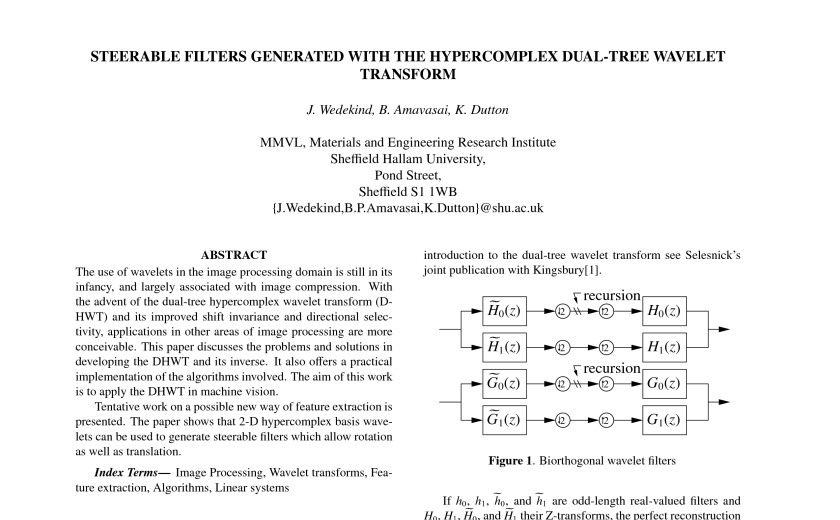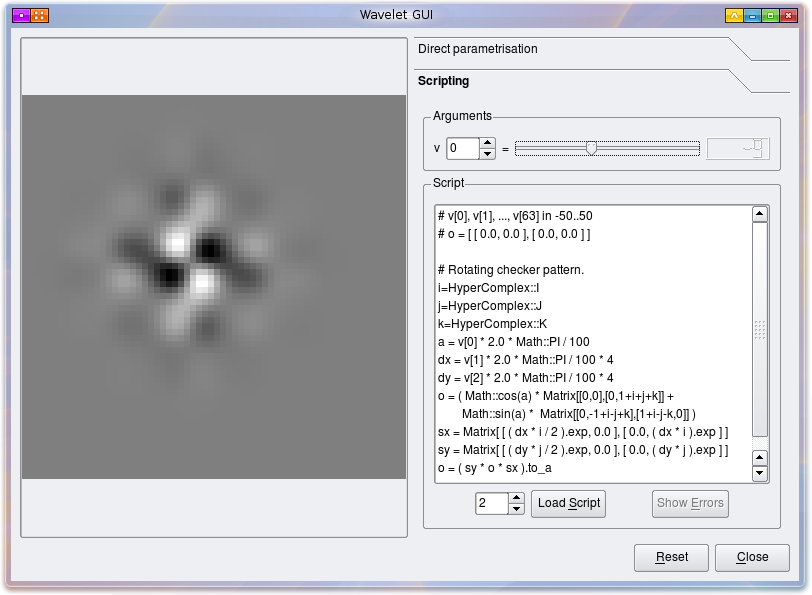Hypercomplex Wavelets
m (→Wavelet Editor) |
(Added wavelet animation) |
||
| Line 27: | Line 27: | ||
=External Links= | =External Links= | ||
| + | <html><div class="floatright"><span><a href="/mmvlwiki/index.php/Image:Wavelet_Transforms.gif" class="image" title=""><img src="/mmvlwiki/images/1/1b/Wavelet_Transforms.gif" alt="" width="120" longdesc="/mmvlwiki/index.php/Image:Wavelet_Transforms.gif" /></a></span></div></html> | ||
* [http://taco.poly.edu/selesi/ Ivan Selesnick's homepage] | * [http://taco.poly.edu/selesi/ Ivan Selesnick's homepage] | ||
* [http://www-sigproc.eng.cam.ac.uk/~ngk/ Nick Kingsbury's homepage] | * [http://www-sigproc.eng.cam.ac.uk/~ngk/ Nick Kingsbury's homepage] | ||
Revision as of 23:34, 20 December 2008
Contents |
Introduction
Complex wavelets are superior to real-valued wavelets because they are nearly shift-invariant. Complex wavelets yield amplitude-phase information in a similar way as the Fourier transform does. In contrast to the Fourier transform, wavelets allow to analyse the signal locally and thus can be applied to signals with a non-stationary statistic (such as images of a natural scene). In the same way as a one-dimensional signal requires complex numbers to represent the local structure of the signal, two-dimensional signals require hypercomplex numbers. Kingsbury has developed the Dual-Tree Complex Wavelet Transform which allows to recursively compute complex wavelet transforms. Analogous to one-dimensional analysis requiring complex values, two-dimensional analysis requires 4-valued complex numbers (hypercomplex values). Bülow, Kingsbury, and others already have successfully used hypercomplex numbers for analysing two-dimensional signals.
Implementation
HornetsEye now contains an implementation of the Dual-Tree Complex Wavelet Transform. The implementation makes use of Hilbert transform pairs of wavelet bases. The wavelet transform was implemented with HornetsEye's MultiArray class. Have a look at the hypercomplex wavelet example for more information.
Wavelet Editor
An editor for visualising linear combinations of wavelets was implemented. The code requires qt4-qtruby, and HornetsEye. The source code is part of the HornetsEye source package. You may need to compile the user interface design file using rbuic4 like this:
rbuic4 waveletEdit.ui > ui_waveletEdit.rb
You can view the source files in their current state at http://bazaar.launchpad.net/~wedesoft/hornetseye/trunk/files in the subdirectory samples/hypercomplex.
See Also
External Links
- Ivan Selesnick's homepage
- Nick Kingsbury's homepage
- N G Kingsbury: Complex wavelets for shift invariant analysis and filtering of signals, Journal of Applied and Computational Harmonic Analysis, vol 10, no 3, May 2001
- J Fauqueur, N Kingsbury and R Anderson: Multiscale keypoint detection using the dual-tree complex wavelet transform, Proc. IEEE Conference on Image Processing, Atlanta, GA, 8-11 Oct 2006
- Thomas Bülow: Hypercomplex Spectral Signal Representations for Image Processing and Analysis, PhD thesis, 1999
- J. Wedekind, B. Amavasai, K. Dutton: Steerable Filters Generated With The Hypercomplex Dual-Tree Wavelet Transform, ICSPC07 proceedings (also see foils (PDF)) (I think there's a bug in the paper. I need to use <math>H_1(z)=(-z)^{-M}\,H_0(z^{-1})</math> (see Selesnicks paper) where <math>M</math> is odd. Maybe this explains the trouble I have with choosing the sampling offsets at the moment)
- Hypercomplex wavelet example
- Related work
- Clyde Davenport's page on commutative hypercomplex mathematics
- K. Krajsek, R. Mester: A Unified theory For Steerable And Quadrature Filters, International Conferences VISAPP and GRAPP 2006



